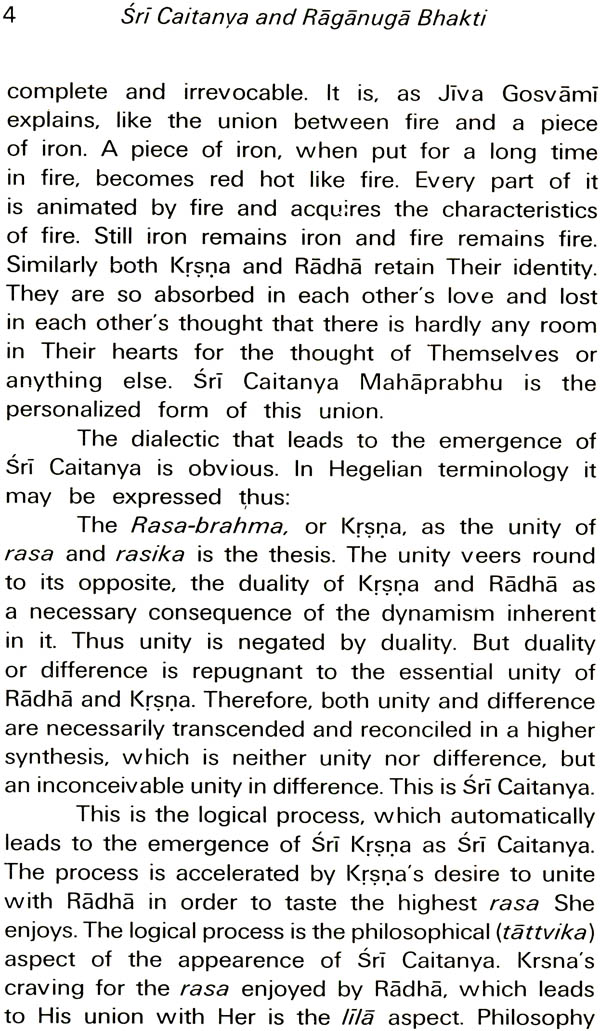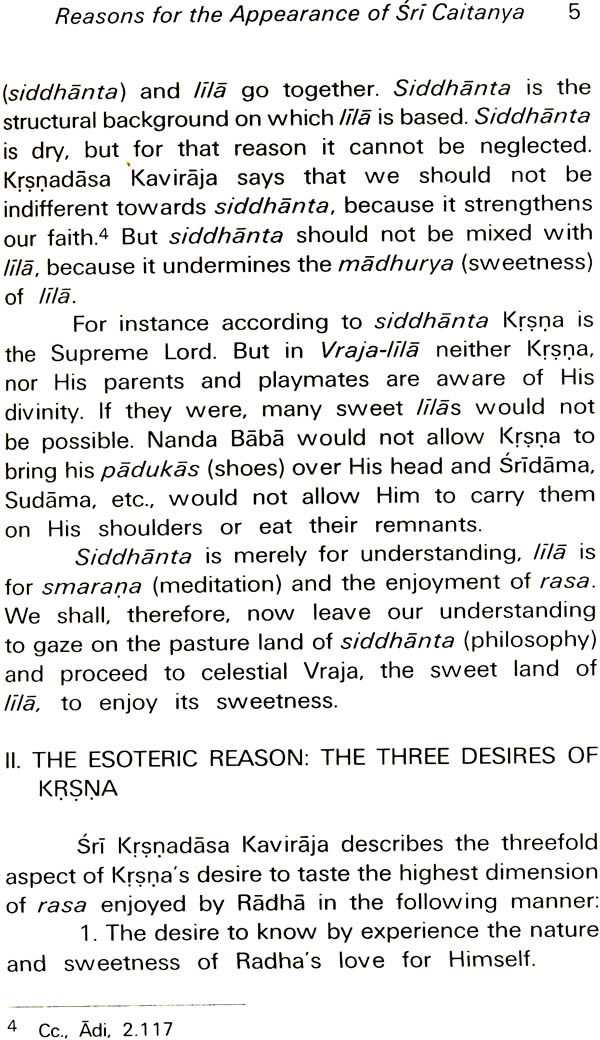
Sri Caitanya (Chaitanya) and Raganuga Bhakti
Book Specification
| Item Code: | IDG608 |
| Author: | Srila Adikesava Prabhu (Dr. Oudh Bihari Lal Kapoor)s |
| Publisher: | THE VAISHNAVA BOOK TURST |
| Edition: | 1995 |
| Pages: | 113 |
| Cover: | Hardcover |
| Other Details | 8.7" X 5.7" |
| Weight | 320 gm |
Book Description
About the Book:
Sri Krsna Himself came down on earth in the form of Sri Caitanya with the sole purpose, as far as we are concerned, of preaching Raganuga Bhakti by precept as well as by example
Sri Caitanya describes the end of Raganuga Bhakti as the realization of the blissful state of complete union between Radha and Krsna in which neither of Them exists as the subject or the object of experience. What exists is only the unique state of blissful union, which experiences itself.
This has given rise to the misconception that in order to realize the highest stage of Raganuga Bhakti one has to imitate Radha and become one with Krsna. This misconception is, here, removed. It is explained how the Manjari Form realize that state without imitation Radha and becoming one with Krsna.
Back of The Book:
The sastras and the saints, therefore, generally advise that sadhaka should practise Nama-samkirtana and cleanse his mind of all impurities before he practices astayma-lika-smarana. Sri Jiva Gosvami not only stresses the need of purifying the mind before doing smarana with Nama-Kirtana when the mind is purified, (Bh.S., Sec. 275; Karma Samdarabha, 1.5.25). According to him smarana is not fruitful without Nama-Kirtana.. In His teaching to Raghunatha Dasa Gosvami Mahaprabhu also emphaisised the necessity of doing smarana with Nama-Kirtana, (Cc. Antya, 6.237).
Publisher's Note:
A word about the author, to whom I am deeply indebted for writing this book on my request, seems necessary.
Srila Adikesava Prabhu (Dr. O.B.L. Kapoor) was born in 1909. He had strong leanings towards the Advaitic philosophy of sankara. In August 1931 he met Sri Srimad Bhaktisiddhanta Sarasvati Gosvami Prabhupada, who pulled him out of his Advaitic moorings and gave him Vaisnava initiation in Radhakunda at the time of his Vrajamandala-Parikarma in 1932. On his suggestion and under his close supervision he wrote a thesis on The Philosophy of Sir Caitanya which was approved for the degree of Doctor of Philosophy by the University of Allahabad. He had, thus, the unique distinction of becoming the first Doctor of Philosophy of this prestigious university.
He worked as Principal and Head of the Philosophy Dept. K.N. Govt. College, Gayanpur, Varanasi. Science his retirement in 1967, he has been living in Vrandavan and writing book relating to Visnavism and the Vaisnava saints in Hindi and English. He has written more than 25 books in Hindi. His contribution to Gaudiya Vaisnava literature in Hindi is immense. In his book titled Vraja-ki-rasopasana he mad a comparative study of the doctrine of Rasa in different Sampradayas of Vraja and proved that the Adi-acarya of Rasa-sastra is Sri Rupa Gosvami and the Acaryas of the other Sampradayas have derived the main principles of their doctrine of Rasa form him. The work won him an award from the U.P. Government.
In English one of his most important contributions is The Philosophy and Religion of Sri Caitanya. The work was highly appreciated by Srila A.C. Bhaktivedanta Swami Prabhupada. The following is photocopy of his appreciation of the book:
Srlla Prabhupada also published a number of articles of Srila Adikesava in the Back to Godhead magazine of ISKCON. In his letter dated July 1, 1973 he wrote to him:
"So I understand that you have written another article "The Absolute as Both Qualified and Unqualified" and transmitted it to the editor. This is very good. This writing is first class preaching and we want to publish more and more of your articles in Back to Godhead."
His other works in English, namely, The Saints of Vraja, The Life of Love, The Gosvamis of vrandavana, Experiences in Bhakti: The science Celestial and The Saints of Bengal, have been widely acclaimed.
In the present work Srila Adikesva has given a succinct, precise and authoritative description of Sri Caitanya Mahaprabhu's contribution to Raganuga Bhakti and has set aside certain misunderstandings that prevail regarding sadhya(End) and Sadhana (Means) in Raganuga Bhakti as preached by Mahaprabhu.
Sri Krsna Himself came down on earth in the form of Sri Caitanya with the sole purpose, as far as we are concerned, of preaching Raganuga Bhakti by precept as well as by example. This by itself explains the supreme importance of Raganuga Bhakti. Sri Caitanya defines Raganuga Bhakti as Bhakti, which is governed by Raga or Love, as against Vaidhi Bhekti. which is governed by Law, or the rules and regulations of the sastras. In this book the concept of Raganuga Bhakti is clearly explained as also the relative importance of Raganuga Bhakti and Vaidhi Bhakti.
Sri Caitanya describes the end of Raganuga Bhakti as the realization of the blissful state of complete union between Radha and Krsna in which neither of Them exists as the subject or the object of experience. What exists is only the unique state of blissful union, which experiences itself.
This has given rise to the misconception that in order to realize the highest stage of Raganuga Bhakti one has to imitate Radha and become one with Krsna. This misconception is, here, removed.
It is explained how the sadhaka can in his tran- scendental Manjari form realize that state without imitating Radha and becoming one with Krsna.
In this connection the concept of transcendental body and the upasana of Manjari Bhava. including Astakalina-lile-smarana, are thoroughly explained. It is, however, emphasised that the sastras deprecate the practice of the upasana of Manjari Bhava until the heart is purified by constant repetition of the Holy Name.
I am grateful to my good friend Sri Radharamana Sadhu for kindly composing, designing and publishing the work expeditiously.
| PUBLISHER'S NOTE
| vii | ||
| PREFACE
| xi | ||
| CHAPTER I REASONS FOR THE APPEARANCE OF SRI CAITANYA | |||
| I. | THE LOGICAL REASON: THE DIALECTIC OF RASA | 1 | |
| II. | THE ESOTERIC REASON: THE THREE DESIRES OF KRSNA | 5 | |
| FIRST DESIRE | 6 | ||
| SECOND DESIRE | 8 | ||
| THIRD DESIRE | 11 | ||
| III. | THE EXOTERIC REASON: PREACHING RAGANUGA BHAKTI
| 17 | |
| CHAPTER II VAIDHI BHAKTI | |||
| TYPES OF VAIDHI BHAKTI
| 19 | ||
| CHAPTER III RAGATMIKA BHAKTI
| 31 | ||
| CHAPTER IV RAGANUGA BHAKTI | 37 | ||
| RELATIVE IMPORTANCE OF RAGANUGA BHAKTI AND VAIDHI BHAKTI | 49 | ||
| STAGES IN THE DEVELOPMENT OF RAGANUGA BHAKTI
| 54 | ||
| CHAPTER V THE TRANSCENDENTAL BODY EXAMPLES OF THE FUNCTIONING OF THE TRANSCENDENTAL BODY | 68 | ||
| (A) | NRSINHANANDA (NAKULA) BRAHMACARI | 68 | |
| (B) | RAMA DASA | 70 | |
| (C) | SRINIVASA ACARYA PRABHU AND RAMACANDRA DASA | 72 | |
| (D) | SRI KRSNA DASA BABA OF GOVARDHANA | 74 | |
| (E) | SRI SANEHI RAMAJI | 76 | |
| (F) | THAKURA KISANA SINHA RATHORA | 78 | |
| (G) | SRI GAURANGA DASA BABAJI | 79 | |
| THE LADY OF BOMBAY
| 82 | ||
| CHAPTER VI MANAJARI BHAVA
| 83 | ||
| CHAPTER VII ASTAKALINA-LILA-SMARANA | 93 | ||







